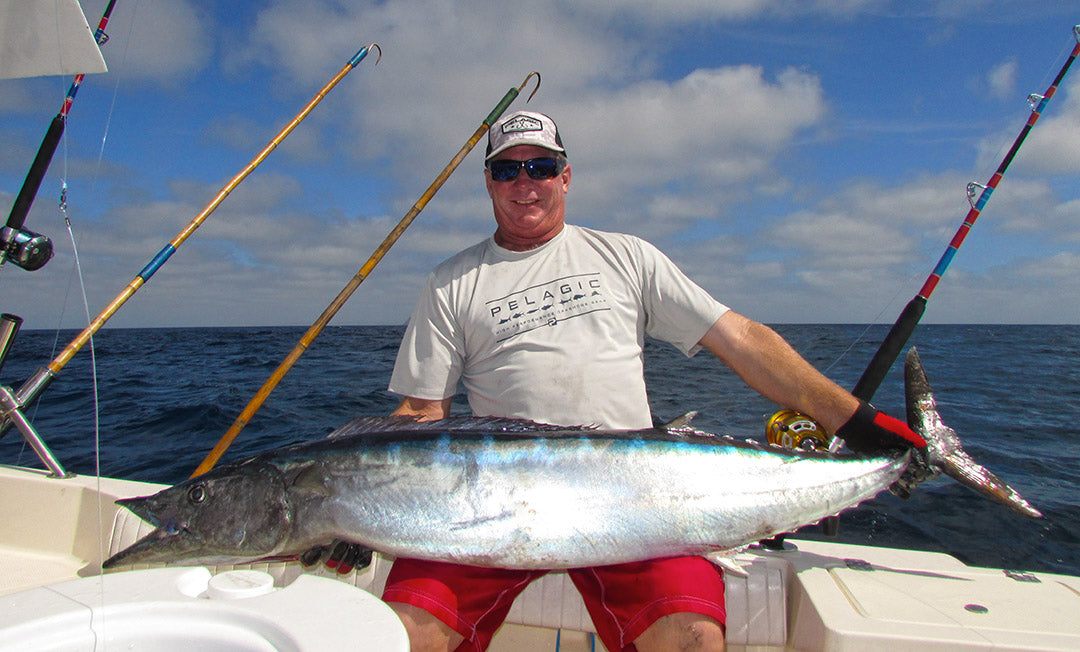
Wahoo are large, predatory members of the mackerel family that predominantly live in the upper-water column epipelagic zone of the open oceans. Considered larger than any other mackerel in its taxonomy (non-tuna), Acanthocybium solandri has a maximum size range of over 180-pounds and can reach lengths of nearly seven feet – the IGFA All-Tackle World Record was caught in Cabo San Lucas, Mexico by angler, Sara Hayward, in July 2005 and weighed in at an astounding 184.0-lbs.
Angler, Sara Hayward, and her All-Tackle IGFA World Record Wahoo
Also known and marketed as Ono – the Hawaiian word for “delicious” – wahoo offer incredible table fare with their sensationally tender and versatile white meat that can be prepared in a multitude of different recipes, cooking methods, and flavor profiles.
Wahoo are strong swimmers and are considered one of the fastest fish in the ocean, exhibiting blinding speed when targeting its prey, which are primarily schooling bait fishes and cephalopods. Their aerodynamic, torpedo-like shape provides a platform for intense speed bursts with their powerful, mid-V tail the vessel of propulsion. A true apex predator, wahoo are aggressive hunters with incredibly sharp teeth that can easily slice a meal in half with its scissor-like jaws. When hunting or simply exited, wahoo will flash a brilliant display of different-hued silvers and blues while often showing off or hiding dark vertical bars in effort to confuse their quarry.
The razor-lined jaws of a wahoo are the ultimate mark of a true predator
Wahoo are typically a solitary species or hunt in small “wolfpacks”. During mating, however, they congregate to form larger groups and reproduce by a behavior known as broadcast spawning where females release their eggs into the currents to be then fertilized by the nearby males. This act heavily increases the probability that eggs will become fertilized and that the fertilized eggs will not be eaten by scavengers. Wahoo reproduce several times during a spawning season, with studies of females shown to produce several million eggs each year. A fast-growing species, wahoo will reach sexual maturity in its first year.
During the Pacific Ocean's El Niño event in 2015, high water temperatures brought wahoo from Baja to higher latitudes affording Southern California anglers a brief opportunity to target the seldom-seen species in their state waters.

Typically thriving in tropical and subtropical regions of the Atlantic, Pacific, and Indian Oceans, wahoo predominantly live-in open oceans while following currents and preferred temperature breaks with preferred water temperatures of 72-80° Fahrenheit; however, they can also be found near shallower wrecks and reefs. Wahoo will often associate with floating objects such as sargassum weed, kelp, trash debris, and FAD’s (fish aggregating devices), which all attract other forms of life that they will feed on.
High-speed trolling is a popular & deadly tactic when targeting wahoo of the east coast of Florida and into the Caribbean Islands.
A prized catch by sport fishermen, conventional fishing methods when targeting wahoo include trolling, vertical jigging, and live baiting. Incidentally, wahoo will also be hooked while fishing via kite, producing incredible aerial displays when attacking surface-displayed live baits. When hooked, wahoo make drag-screaming runs with larger models known to nearly spool under gunned tackle before settling into a back-and-forth fight with their angler opponents.
This wahoo was enticed to bite a heavy iron jig cast & retrieved at high-speeds aboard the world-famous EXCEL Long Range Fishing Vessel
Images courtesy of Adrian Gray, Geoffrey Ragatz, Excel Sportfishing, & The IGFA.
Back to stories